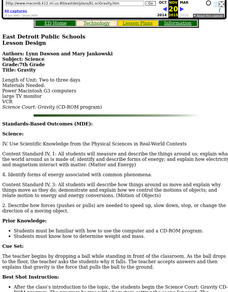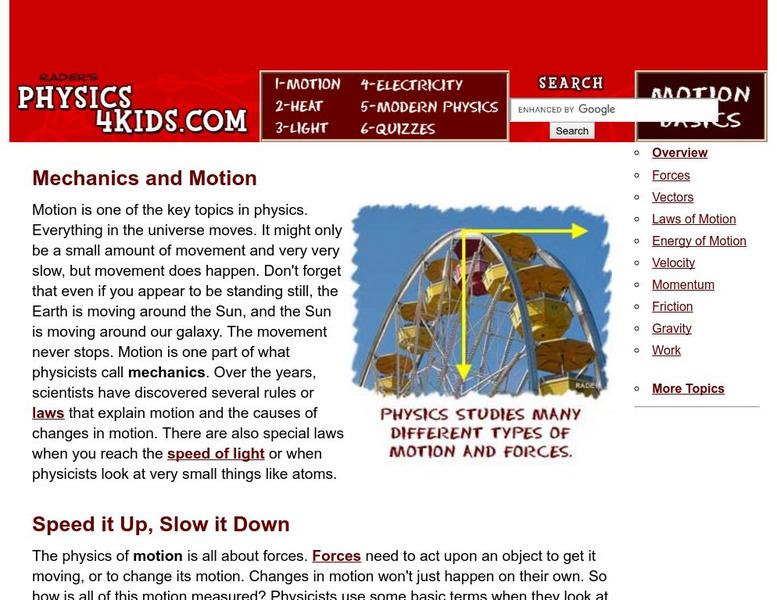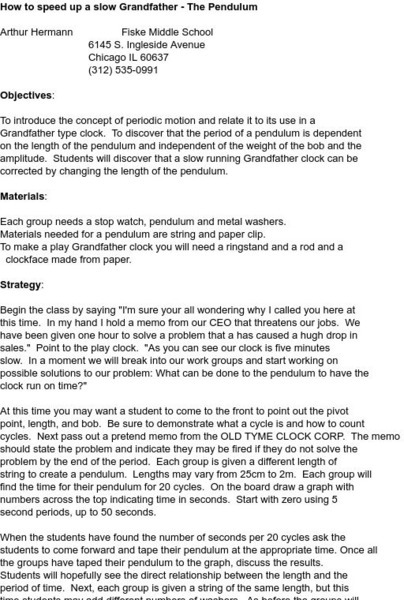Curated OER
Science: Avalanche!
Eighth graders examine avalanches after reading excerpts from John Muir's book, "The Yosemite." In small groups, they conduct experiments with flour, sugar, and potato flakes representing different snow consistencies. Then, 8th graders...
Curated OER
That Mu You Do
Students are told that the weight of a car is equal to its mass multiplied by the acceleration due to gravity. When a car is at react on a horizontal road, there must be a normal force with which the road pushes up on the car to keep it...
Curated OER
Who's the Frog Jumping Champion?
Students use a simple machine (a lever) to launch a plastic frog. students determine who is able to make their frog "jump" the farthest and graph the results.
Curated OER
Forces and Pressure
In this forces worksheet, learners will review the different types of forces and how forces are measured. This worksheet has 9 fill in the blank, 1 short answer, and 11 multiple choice questions.
Curated OER
Hurricanes 2: Tracking Hurricanes
Students examine the role of technology in identifying and tracking hurricanes.
Curated OER
Kepler's Second Law
Students explore orbital velocities and how they vary along each orbit, according to Kepler's Second Law.
Curated OER
"Ball Bounce" Quadratic Functions
Young scholars manipulate a ball and explore quadratic functions. In this algebra lesson, learners analyze the graph of a quadratic function. They identify quadratic properties.
Curated OER
Gravity
Seventh graders progress through the Science Court: Gravity CD-ROM program. They read about and discuss how gravity was discovered. They complete review worksheets in preparation for the test.
Curated OER
Aerodynamic drag
Students construct a device that can launch spinning balls. One example would be a mailing tube with one side partially cut away, lined with sandpaper. Styrofoam balls should be used for the greatest effet. They are explained how a...
Curated OER
Colored Clouds
Fourth graders, in groups, examine how particles in warm water move faster than particles in cold water.
Physics Classroom
The Physics Classroom:vectors and Projectiles:throw at a Slow Speed With Gravity
In this animation, students can visualize and imagine throwing a projectile in slow speed in a normal gravity situation.
Other
Bscs: Forces and Motion Content Background Document
In this document, we will try to answer a fundamental question of physical science, "Why do things start to move, slow down, speed up, stop moving or change direction?" In answering these core questions we can develop concepts that can...
Walter Fendt
Walter Fendt: Uniform Circular Motion
This app simulates circular movement and demonstrates how the position, speed, acceleration, and the applied force vary depending on the time. You may choose the option "slow animation" to make the movement ten times slower. You can also...
Texas Instruments
Texas Instruments: Slow Down: Speed Up
In this activity, students' will use a motion detector to observe the effect of speeding up, slowing down, and moving at a constant rate on a Distance versus Time plot.
Physics4kids
Physics 4 Kids: Mechanics and Motion
Motion is one of the key topics in physics. Everything in the universe moves. It might only be a small amount of movement and very very slow, but movement does happen. Don't forget that even if you appear to be standing still, the Earth...
Science and Mathematics Initiative for Learning Enhancement (SMILE)
Smile: How to Speed Up a Slow Grandfather: The Pendulum
In this lesson plan students are "given one hour to solve a problem that a has caused a huge drop in sales" for a clock company. All clocks are five minutes slow. Because of this, they must find a way to put the clock back on time...
Science Education Resource Center at Carleton College
Serc: Direction of Acceleration
In this short lab, young scholars use Tonka trucks to observe the acceleration of a object as it initiates acceleration, maintains a steady speed, and slows to a stop.
















